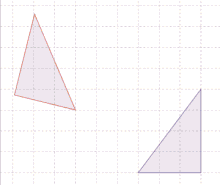Isometry
Isometry[1] is a concept of geometry.[2] Isometry means that one shape can be transformed into another, but metrics such as the arrangement of the points in relation to each other stay the same. An isometry is a special way of changing things that makes sure the distance between every two points stays the same in both places.An isometry is a special kind of function that moves points around from one place to another. Some of these ways include turning objects, moving them in a straight line, flipping them, sliding them, or not moving them at all.



Most transformation that repeats itself after every two moves can either be a mirror image or a rotation by half. Every movement in a flat surface can be made by reflecting[3] it at most three times. Every small group of transformations has at least one point that doesn't move.[4] To be an isometry, a function needs to keep the distances between all points in both places the same. The distance from x to y is the same as the distance from f(x) to f(y).[5]
If you draw something and then move it a certain way, the distances between the points on the first drawing will be the same as on the new drawing. Isometries are useful tools in many areas of mathematics,[6] such as studying shapes, patterns, and how numbers behave. Metric spaces are helpful in Math because they help us study things like symmetry, congruence, and transformations.[7]
References
- "Isometry". Calcworkshop. 2020-01-21. Retrieved 2023-06-01.
- "Geometry | Definition, History, Basics, Branches, & Facts | Britannica". www.britannica.com. 2023-05-14. Retrieved 2023-06-01.
- Nunes, Vitor. "Isometries: Reflection". matematica.pt. Retrieved 2023-06-01.
- Weisstein, Eric W. "Isometry". mathworld.wolfram.com. Retrieved 2023-06-01.
- "Isometries Preserve Distances". new.math.uiuc.edu. Retrieved 2023-06-01.
- "Isometry: Meaning, Types, Examples & Transformation". StudySmarter US. Retrieved 2023-06-01.
- "Transformations". www.mathsisfun.com. Retrieved 2023-06-01.